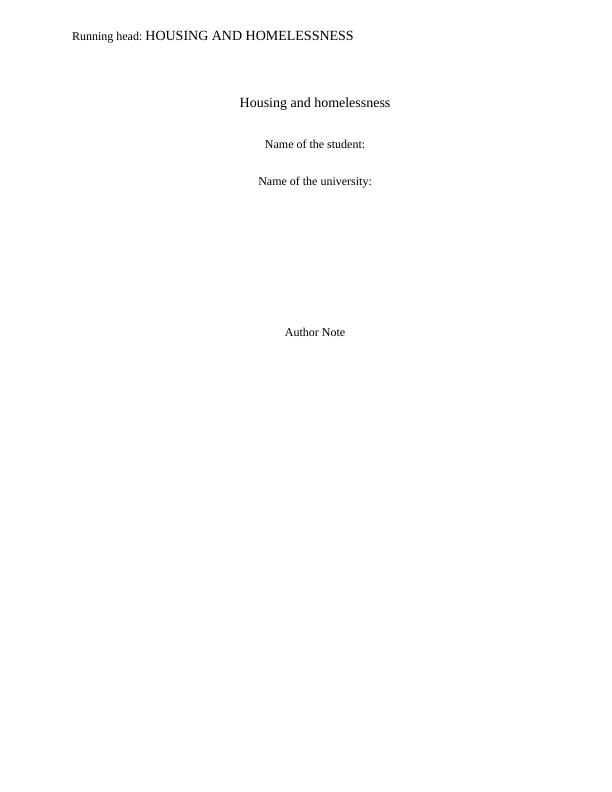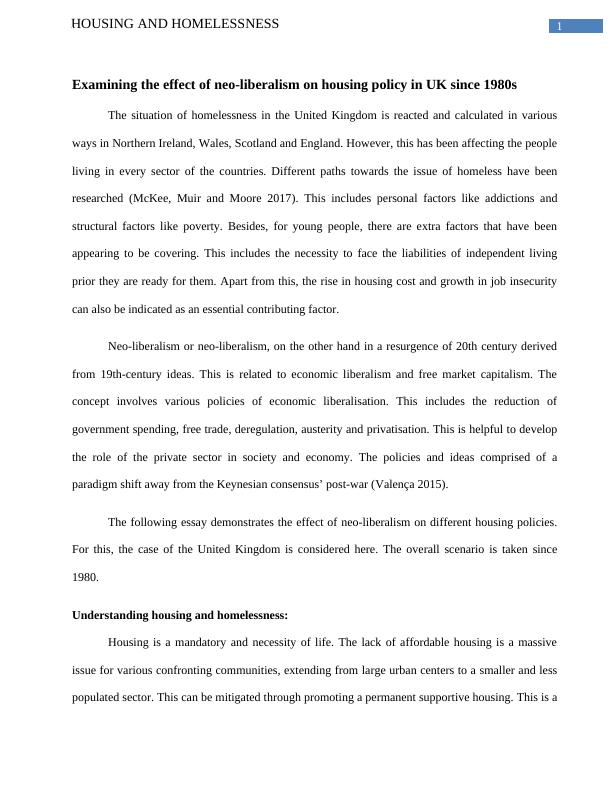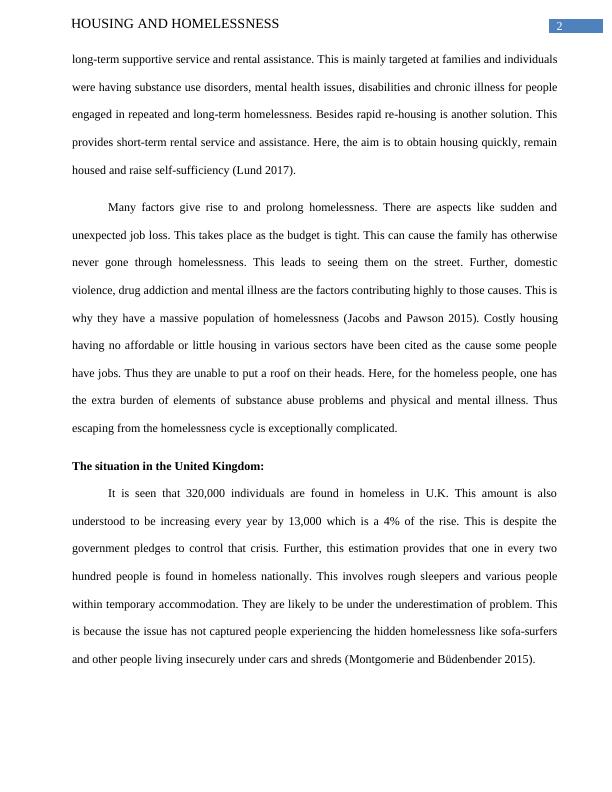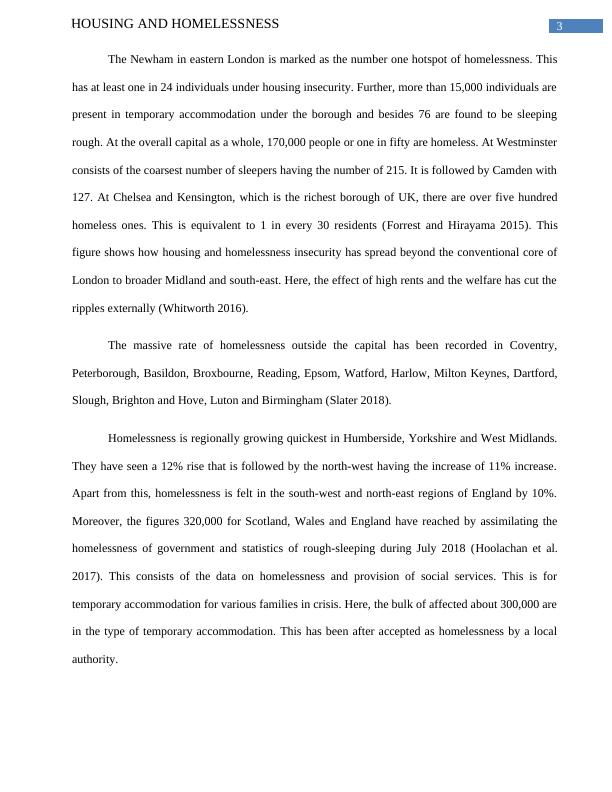Examining the effect of neo-liberalism on housing policy in UK since 1980s
Added on 2023-04-21
11 Pages3599 Words125 Views
Running head: HOUSING AND HOMELESSNESS
Housing and homelessness
Name of the student:
Name of the university:
Author Note
Housing and homelessness
Name of the student:
Name of the university:
Author Note

1HOUSING AND HOMELESSNESS
Examining the effect of neo-liberalism on housing policy in UK since 1980s
The situation of homelessness in the United Kingdom is reacted and calculated in various
ways in Northern Ireland, Wales, Scotland and England. However, this has been affecting the people
living in every sector of the countries. Different paths towards the issue of homeless have been
researched (McKee, Muir and Moore 2017). This includes personal factors like addictions and
structural factors like poverty. Besides, for young people, there are extra factors that have been
appearing to be covering. This includes the necessity to face the liabilities of independent living
prior they are ready for them. Apart from this, the rise in housing cost and growth in job insecurity
can also be indicated as an essential contributing factor.
Neo-liberalism or neo-liberalism, on the other hand in a resurgence of 20th century derived
from 19th-century ideas. This is related to economic liberalism and free market capitalism. The
concept involves various policies of economic liberalisation. This includes the reduction of
government spending, free trade, deregulation, austerity and privatisation. This is helpful to develop
the role of the private sector in society and economy. The policies and ideas comprised of a
paradigm shift away from the Keynesian consensus’ post-war (Valença 2015).
The following essay demonstrates the effect of neo-liberalism on different housing policies.
For this, the case of the United Kingdom is considered here. The overall scenario is taken since
1980.
Understanding housing and homelessness:
Housing is a mandatory and necessity of life. The lack of affordable housing is a massive
issue for various confronting communities, extending from large urban centers to a smaller and less
populated sector. This can be mitigated through promoting a permanent supportive housing. This is a
Examining the effect of neo-liberalism on housing policy in UK since 1980s
The situation of homelessness in the United Kingdom is reacted and calculated in various
ways in Northern Ireland, Wales, Scotland and England. However, this has been affecting the people
living in every sector of the countries. Different paths towards the issue of homeless have been
researched (McKee, Muir and Moore 2017). This includes personal factors like addictions and
structural factors like poverty. Besides, for young people, there are extra factors that have been
appearing to be covering. This includes the necessity to face the liabilities of independent living
prior they are ready for them. Apart from this, the rise in housing cost and growth in job insecurity
can also be indicated as an essential contributing factor.
Neo-liberalism or neo-liberalism, on the other hand in a resurgence of 20th century derived
from 19th-century ideas. This is related to economic liberalism and free market capitalism. The
concept involves various policies of economic liberalisation. This includes the reduction of
government spending, free trade, deregulation, austerity and privatisation. This is helpful to develop
the role of the private sector in society and economy. The policies and ideas comprised of a
paradigm shift away from the Keynesian consensus’ post-war (Valença 2015).
The following essay demonstrates the effect of neo-liberalism on different housing policies.
For this, the case of the United Kingdom is considered here. The overall scenario is taken since
1980.
Understanding housing and homelessness:
Housing is a mandatory and necessity of life. The lack of affordable housing is a massive
issue for various confronting communities, extending from large urban centers to a smaller and less
populated sector. This can be mitigated through promoting a permanent supportive housing. This is a

2HOUSING AND HOMELESSNESS
long-term supportive service and rental assistance. This is mainly targeted at families and individuals
were having substance use disorders, mental health issues, disabilities and chronic illness for people
engaged in repeated and long-term homelessness. Besides rapid re-housing is another solution. This
provides short-term rental service and assistance. Here, the aim is to obtain housing quickly, remain
housed and raise self-sufficiency (Lund 2017).
Many factors give rise to and prolong homelessness. There are aspects like sudden and
unexpected job loss. This takes place as the budget is tight. This can cause the family has otherwise
never gone through homelessness. This leads to seeing them on the street. Further, domestic
violence, drug addiction and mental illness are the factors contributing highly to those causes. This is
why they have a massive population of homelessness (Jacobs and Pawson 2015). Costly housing
having no affordable or little housing in various sectors have been cited as the cause some people
have jobs. Thus they are unable to put a roof on their heads. Here, for the homeless people, one has
the extra burden of elements of substance abuse problems and physical and mental illness. Thus
escaping from the homelessness cycle is exceptionally complicated.
The situation in the United Kingdom:
It is seen that 320,000 individuals are found in homeless in U.K. This amount is also
understood to be increasing every year by 13,000 which is a 4% of the rise. This is despite the
government pledges to control that crisis. Further, this estimation provides that one in every two
hundred people is found in homeless nationally. This involves rough sleepers and various people
within temporary accommodation. They are likely to be under the underestimation of problem. This
is because the issue has not captured people experiencing the hidden homelessness like sofa-surfers
and other people living insecurely under cars and shreds (Montgomerie and Büdenbender 2015).
long-term supportive service and rental assistance. This is mainly targeted at families and individuals
were having substance use disorders, mental health issues, disabilities and chronic illness for people
engaged in repeated and long-term homelessness. Besides rapid re-housing is another solution. This
provides short-term rental service and assistance. Here, the aim is to obtain housing quickly, remain
housed and raise self-sufficiency (Lund 2017).
Many factors give rise to and prolong homelessness. There are aspects like sudden and
unexpected job loss. This takes place as the budget is tight. This can cause the family has otherwise
never gone through homelessness. This leads to seeing them on the street. Further, domestic
violence, drug addiction and mental illness are the factors contributing highly to those causes. This is
why they have a massive population of homelessness (Jacobs and Pawson 2015). Costly housing
having no affordable or little housing in various sectors have been cited as the cause some people
have jobs. Thus they are unable to put a roof on their heads. Here, for the homeless people, one has
the extra burden of elements of substance abuse problems and physical and mental illness. Thus
escaping from the homelessness cycle is exceptionally complicated.
The situation in the United Kingdom:
It is seen that 320,000 individuals are found in homeless in U.K. This amount is also
understood to be increasing every year by 13,000 which is a 4% of the rise. This is despite the
government pledges to control that crisis. Further, this estimation provides that one in every two
hundred people is found in homeless nationally. This involves rough sleepers and various people
within temporary accommodation. They are likely to be under the underestimation of problem. This
is because the issue has not captured people experiencing the hidden homelessness like sofa-surfers
and other people living insecurely under cars and shreds (Montgomerie and Büdenbender 2015).

3HOUSING AND HOMELESSNESS
The Newham in eastern London is marked as the number one hotspot of homelessness. This
has at least one in 24 individuals under housing insecurity. Further, more than 15,000 individuals are
present in temporary accommodation under the borough and besides 76 are found to be sleeping
rough. At the overall capital as a whole, 170,000 people or one in fifty are homeless. At Westminster
consists of the coarsest number of sleepers having the number of 215. It is followed by Camden with
127. At Chelsea and Kensington, which is the richest borough of UK, there are over five hundred
homeless ones. This is equivalent to 1 in every 30 residents (Forrest and Hirayama 2015). This
figure shows how housing and homelessness insecurity has spread beyond the conventional core of
London to broader Midland and south-east. Here, the effect of high rents and the welfare has cut the
ripples externally (Whitworth 2016).
The massive rate of homelessness outside the capital has been recorded in Coventry,
Peterborough, Basildon, Broxbourne, Reading, Epsom, Watford, Harlow, Milton Keynes, Dartford,
Slough, Brighton and Hove, Luton and Birmingham (Slater 2018).
Homelessness is regionally growing quickest in Humberside, Yorkshire and West Midlands.
They have seen a 12% rise that is followed by the north-west having the increase of 11% increase.
Apart from this, homelessness is felt in the south-west and north-east regions of England by 10%.
Moreover, the figures 320,000 for Scotland, Wales and England have reached by assimilating the
homelessness of government and statistics of rough-sleeping during July 2018 (Hoolachan et al.
2017). This consists of the data on homelessness and provision of social services. This is for
temporary accommodation for various families in crisis. Here, the bulk of affected about 300,000 are
in the type of temporary accommodation. This has been after accepted as homelessness by a local
authority.
The Newham in eastern London is marked as the number one hotspot of homelessness. This
has at least one in 24 individuals under housing insecurity. Further, more than 15,000 individuals are
present in temporary accommodation under the borough and besides 76 are found to be sleeping
rough. At the overall capital as a whole, 170,000 people or one in fifty are homeless. At Westminster
consists of the coarsest number of sleepers having the number of 215. It is followed by Camden with
127. At Chelsea and Kensington, which is the richest borough of UK, there are over five hundred
homeless ones. This is equivalent to 1 in every 30 residents (Forrest and Hirayama 2015). This
figure shows how housing and homelessness insecurity has spread beyond the conventional core of
London to broader Midland and south-east. Here, the effect of high rents and the welfare has cut the
ripples externally (Whitworth 2016).
The massive rate of homelessness outside the capital has been recorded in Coventry,
Peterborough, Basildon, Broxbourne, Reading, Epsom, Watford, Harlow, Milton Keynes, Dartford,
Slough, Brighton and Hove, Luton and Birmingham (Slater 2018).
Homelessness is regionally growing quickest in Humberside, Yorkshire and West Midlands.
They have seen a 12% rise that is followed by the north-west having the increase of 11% increase.
Apart from this, homelessness is felt in the south-west and north-east regions of England by 10%.
Moreover, the figures 320,000 for Scotland, Wales and England have reached by assimilating the
homelessness of government and statistics of rough-sleeping during July 2018 (Hoolachan et al.
2017). This consists of the data on homelessness and provision of social services. This is for
temporary accommodation for various families in crisis. Here, the bulk of affected about 300,000 are
in the type of temporary accommodation. This has been after accepted as homelessness by a local
authority.

End of preview
Want to access all the pages? Upload your documents or become a member.
Related Documents
Poverty and Homelessnesslg...
|10
|2779
|21
Dual Diagnosis Co-Morbidity and Society Article 2022lg...
|17
|4399
|11
Young People and Rough Sleeping in London: A Qualitative Studylg...
|10
|2719
|27
Street Policing of Problem Druglg...
|14
|3308
|33